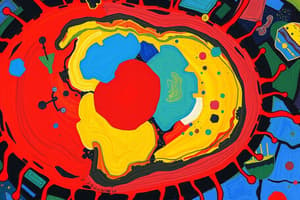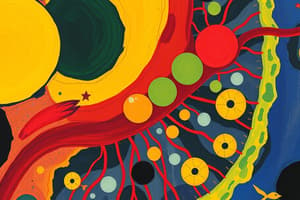Podcast
Questions and Answers
What key feature do mitochondria and plastids possess that relates to their evolutionary origins?
What key feature do mitochondria and plastids possess that relates to their evolutionary origins?
- They are identical to eukaryotic cytoplasmic ribosomes.
- They descended from free living organisms and have their own DNA. (correct)
- They can synthesize proteins independently of the cell.
- They lack DNA and rely solely on nuclear genes.
How do the ribosomes in mitochondria and plastids compare to those in eukaryotic cells?
How do the ribosomes in mitochondria and plastids compare to those in eukaryotic cells?
- They resemble bacterial ribosomes more than eukaryotic ribosomes. (correct)
- They are completely unique and unrelated to any other ribosome type.
- They only function in the nucleus and do not translate proteins.
- They are larger and more complex.
What role do histones play in the structure of chromosomes?
What role do histones play in the structure of chromosomes?
- They provide the energy required for DNA replication.
- They help condense DNA into chromatin. (correct)
- They are the primary structural components of ribosomes.
- They are responsible for the synthesis of RNA.
Which statement accurately describes homologous structures?
Which statement accurately describes homologous structures?
Where are chromosomes located in animal and plant cells?
Where are chromosomes located in animal and plant cells?
Flashcards are hidden until you start studying
Study Notes
Organelles and Their Characteristics
- Mitochondria and plastids evolved from free-living organisms, retaining cellular machinery necessary for protein synthesis.
- Both organelles possess ribosomes that allow them to transcribe and translate their own DNA into proteins.
Ribosomal Comparisons
- Mitochondrial and plastid ribosomes resemble bacterial ribosomes in several aspects, such as size, RNA sequences, and reaction to specific antibiotics.
- This similarity indicates a close evolutionary relationship between these organelles and bacteria, differing from the ribosomes found in eukaryotic cytoplasm.
Biological Terms
- Homologous refers to structures having a similar relative position, value, or configuration, exemplified by a human arm (humerus) being homologous to the bat wing or mammalian front leg.
- Histones are basic proteins that associate with DNA in the nucleus, playing a crucial role in condensing DNA into chromatin.
Chromosomes
- Chromosomes are thread-like structures situated within the nucleus of both animal and plant cells, formed from DNA and histone proteins.
Studying That Suits You
Use AI to generate personalized quizzes and flashcards to suit your learning preferences.





